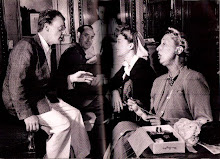 I just recently watched the 1934 James Cagney film The St. Louis Kid for the first time, and it was good. James Cagney was good as Eddie Kennedy, the pugnacious truck driver who always finds himself in jail and uses a new method of punching guys--using his head (literally)! In The St. Louis Kid (1934), his nineteenth picture, James Cagney plays a truck driver who gets embroiled in a "milk war" between a trucking company and striking dairymen - a topical subject of the time. The trucking company is determined to maintain its milk shipments even though the dairymen are on strike. When a dairy worker is murdered, Cagney is accused of the crime and must find the real killer to clear himself. He also must rescue his kidnapped girlfriend (Patricia Ellis) in this zippy little film which runs barely over an hour.
I just recently watched the 1934 James Cagney film The St. Louis Kid for the first time, and it was good. James Cagney was good as Eddie Kennedy, the pugnacious truck driver who always finds himself in jail and uses a new method of punching guys--using his head (literally)! In The St. Louis Kid (1934), his nineteenth picture, James Cagney plays a truck driver who gets embroiled in a "milk war" between a trucking company and striking dairymen - a topical subject of the time. The trucking company is determined to maintain its milk shipments even though the dairymen are on strike. When a dairy worker is murdered, Cagney is accused of the crime and must find the real killer to clear himself. He also must rescue his kidnapped girlfriend (Patricia Ellis) in this zippy little film which runs barely over an hour. Production began on July 16, 1934. On July 19, Warner Bros. production chief Hal Wallis sent director Ray Enright a memo, which read in part: "Your first two days' dailies, generally, look very good. The action is good and your set-ups are OK but there is one major criticism and that is in Cagney's characterization... I know that, when he first read the script, he objected to playing another tough character and I can see that he is doing his best to soften him up and make him as much of a gentleman as possible...It is true that we don't want to play him as tough as he usually plays these things as there is naturally an objection to slugging dames and all of that stuff today but, at the same time, we don't want to lose Cagney's real characterization which is a semi-tough character... It is going to hurt the picture considerably unless you change immediately." In a follow-up memo, Wallis wrote: "I want you to call me...when you get this and let me know if you are directing the picture or if Cagney is directing it." A snide remark, to be sure, but it illustrates the power struggle that often went on as both the studio and the star battled over shaping the star's on-screen persona.
Production began on July 16, 1934. On July 19, Warner Bros. production chief Hal Wallis sent director Ray Enright a memo, which read in part: "Your first two days' dailies, generally, look very good. The action is good and your set-ups are OK but there is one major criticism and that is in Cagney's characterization... I know that, when he first read the script, he objected to playing another tough character and I can see that he is doing his best to soften him up and make him as much of a gentleman as possible...It is true that we don't want to play him as tough as he usually plays these things as there is naturally an objection to slugging dames and all of that stuff today but, at the same time, we don't want to lose Cagney's real characterization which is a semi-tough character... It is going to hurt the picture considerably unless you change immediately." In a follow-up memo, Wallis wrote: "I want you to call me...when you get this and let me know if you are directing the picture or if Cagney is directing it." A snide remark, to be sure, but it illustrates the power struggle that often went on as both the studio and the star battled over shaping the star's on-screen persona.
In this film, it is said that James Cagney's character is 24 years old; Cagney himself was already 35 years old (already entering middle-age) when he did this film. However, because of his baby face, he could easily have gotten away with playing someone 11 years younger than himself!! And Cagney the country gentleman is made obvious by his lines in which he speaks highly of the countryside and praises the farmers of America (I'm pretty sure he ad-libbed those lines)! Speaking of which, some critics complained that the picture would have been far more interesting if it had delved more deeply into the politics of the milk wars, but almost all admired the film's fast pace. Many also noted that the movie inverts a memorable feature of some of Cagney's previous films: "The St. Louis Kid shows James Cagney receiving a cuff on the jaw from his leading lady instead of giving her one," observed Time. "He can take it as well as dish it out," said The New York Times. "He permits himself to be slapped vigorously by Patricia Ellis, [and his] response is limited in violence to what the cinema literateurs picturesquely refer to as a dirty look."And Cagney seemed to use that dirty look rather mischievously and cutely!


Supporting player Allen Jenkins, a fixture in working-class Warner melodramas and comedies of the era, appeared with Cagney five times, usually as the comic sidekick. In the book Warner Brothers Presents, film historian Ted Sennett wrote vividly of Jenkins: "Cabbie, gangster, manager, sidekick, he had the battered but tenacious look of the urban animal who had been around - and intends to stay around." (And besides seeing him in Cagney pictures, I think I remember seeing Allen Jenkins in one episode of I Love Lucy as well. For those of you who are also big fans of I Love Lucy, you should know what I'm talking about.)


Supporting player Allen Jenkins, a fixture in working-class Warner melodramas and comedies of the era, appeared with Cagney five times, usually as the comic sidekick. In the book Warner Brothers Presents, film historian Ted Sennett wrote vividly of Jenkins: "Cabbie, gangster, manager, sidekick, he had the battered but tenacious look of the urban animal who had been around - and intends to stay around." (And besides seeing him in Cagney pictures, I think I remember seeing Allen Jenkins in one episode of I Love Lucy as well. For those of you who are also big fans of I Love Lucy, you should know what I'm talking about.)

Co-star Patricia Ellis, a now-forgotten actress of low-budget 1930s Warner Bros. movies, was a last-minute replacement for Ann Dvorak, who had herself replaced Margaret Lindsay. Speaking of which, I enjoyed the fact that Cagney and the actress started out as backstabbing enemies (in one scene, she puts Tobasco sauce on his toast and I just love it when he goes outside and spits it out) but became rather disappointed when they became boyfriend and girlfriend.
The St. Louis Kid was supposedly Cagney's first "Code" film, while according to most sources, that honor belongs to Here Comes the Navy (fun fact: Cagney became one of the Top 10 box-office draws during the year 1934, next to Shirley Temple and Clark Gable). It was a project apropos of his recent election to Vice President of the Screen Actors Guild. Anyway, in the end, the Cagney couple get married and spend their honeymoon in jail after being busted by an innkeeper. This ending is an obvious example of the type of film Warner Brothers began producing after the Production Code was enforced.


The St. Louis Kid is a prime example of the studio's blend of compromised liberalism, cocky tough-guy action and situation comedy that emerged after mid-1934. Hollywood liked to place the blame for labor troubles in the 1930s when it could, so that it did not have to confront corporate American responsibility labor violence (I've notice that the same evasion marks Taxi!), but still, the picture was very occasionally funny plus lively.
And I almost forgot to add that Jimmy Cagney dances a little in this film at a local dance--and that's where his girl-enemy falls in love with him. (She is also attracted by his incendiary charm, which is what I'm also attracted by.) And I also almost forgot to add that I was both amused and surprised when Cagney escapes from his handlers after being accused by doing the personally unspeakable: Smoking a cigarette at a gas station in the scene.
 Anyhow, before watching this film, I couldn't understand any of its plot or itself, and I doubt if I could understand it when I watched it. It was a Jim Cagney movie that I wasn't so crazy about seeing but then again, I really wanted to see it! As for the head blows, suitably enhanced by the sound department, they were very surprising and funny, and Cagney would repeat this bit later in a scrap with Bette Davis in The Bride Came C.O.D. (1941). I would recommend this movie for any James Cagney fan who loves seeing him in lively comedy-dramas.
Anyhow, before watching this film, I couldn't understand any of its plot or itself, and I doubt if I could understand it when I watched it. It was a Jim Cagney movie that I wasn't so crazy about seeing but then again, I really wanted to see it! As for the head blows, suitably enhanced by the sound department, they were very surprising and funny, and Cagney would repeat this bit later in a scrap with Bette Davis in The Bride Came C.O.D. (1941). I would recommend this movie for any James Cagney fan who loves seeing him in lively comedy-dramas.

(Next blog [for sure ]: The Bride Came C.O.D. [1941])
]: The Bride Came C.O.D. [1941])
 Anyhow, before watching this film, I couldn't understand any of its plot or itself, and I doubt if I could understand it when I watched it. It was a Jim Cagney movie that I wasn't so crazy about seeing but then again, I really wanted to see it! As for the head blows, suitably enhanced by the sound department, they were very surprising and funny, and Cagney would repeat this bit later in a scrap with Bette Davis in The Bride Came C.O.D. (1941). I would recommend this movie for any James Cagney fan who loves seeing him in lively comedy-dramas.
Anyhow, before watching this film, I couldn't understand any of its plot or itself, and I doubt if I could understand it when I watched it. It was a Jim Cagney movie that I wasn't so crazy about seeing but then again, I really wanted to see it! As for the head blows, suitably enhanced by the sound department, they were very surprising and funny, and Cagney would repeat this bit later in a scrap with Bette Davis in The Bride Came C.O.D. (1941). I would recommend this movie for any James Cagney fan who loves seeing him in lively comedy-dramas.
(Next blog [for sure
 ]: The Bride Came C.O.D. [1941])
]: The Bride Came C.O.D. [1941])
Clips from The St. Louis Kid:












No comments:
Post a Comment